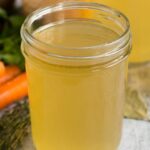
The Best Gluten Free Chicken Stock
This gluten free chicken stock recipe makes the best homemade stock. Using a pre-cooked chicken carcass, either from a rotisserie chicken or one you've cooked on your own, it combines simple ingredients into a flavorful broth. Perfect for soups or just to sip on, it also keeps in the freezer for you to enjoy months later!
Servings 8
Equipment
- A large stock pot with a lid
- A pair of tongs or slotted spoon
- A fine mesh strainer
- Storage containers
- A ladle or funnel
Ingredients
- 1 carcass of a cooked or smoked chicken cleaned of meat and broken down
- 1 small to medium onion
- 1 small shallot
- 10 baby carrots
- 2-3 celery stalks with leaves cut into large chunks
- ⅓ cup mushroom stems shiitake or cremini
- 1-2 large stems fresh thyme
- 1 dried bay leaf
- 1 tablespoon Diamond Crystal kosher salt
- 14-18 cups water enough to cover everything
Instructions
- Put the chicken carcass in a large stock pot.
- Peel and cut up the onion and shallot into large pieces and place in the pot with the chicken pieces.
- Add the celery, carrots, mushroom stems, thyme, bay leaf, and kosher salt to the pot.
- Use a measuring cup to measure the water, pouring it into the pot as well. Make sure the water level is high enough to cover everything.
- Place a lid on the pot and bring it to a boil over high heat. Then reduce the heat to low and let it simmer for 3.5 to 4 hours, adjusting the lid to let a little steam escape.
- After it's done simmering, remove the bones, skin, cooked veggies and herbs from the pot with tongs, either into another large pot or a different container. Discard them once cooled.
- Strain the broth through a fine mesh strainer into another pot to remove any last debris.
- Use a ladle to scoop the broth into storage containers. Wait until the stock is completely cooled then put a lid on the container. Store it in the fridge for 3 to 4 days or in freezer-safe containers for several months.
Video
Notes
- Make sure you've taken the majority of meat off of your chicken carcass before you start! You won't need it for the stock and can instead use it in soups or other dishes.
- Don't throw the cooked veggies and bones straight into the trash can as they will still be hot and cause condensation, making your garbage stink even more. Wait for it to completely cool then throw it away. I typically put mine in a separate small bag (like one from the grocery store) then
- You can easily make this broth in a slow cooker. Just make sure you pour enough water in to cover everything. Cook on high for 4 hours, then follow steps 6 through 8 to drain and store.
- This stock is not very heavily salted and comes out more like a low sodium stock. As with any recipe, be sure and taste any dish you use this stock in as you're cooking to make sure it's salted to your liking - you may need to add more salt than the recipe calls for.
- Make sure you're using a carcass from a pre-cooked chicken, like a rotisserie chicken or my spatchcock smoked chicken. This is going to add extra flavor to your stock and is a vital step. If you buy a rotisserie chicken, read the ingredients to make sure it's gluten free. Also, use both the bones and the skin as both will contribute to the flavor of the broth.
- This recipe calls for baby carrots because that's typically what I have in my fridge and this way you don't have to cut them up. If you have large carrots that's fine, you'll just want to cut them down into 2- to 3-inch pieces.
- To get the most flavor, use a more flavorful mushroom, like shiitake. This recipe calls for the stems of the mushroom only, saving the tops for a different recipe (like this turkey and rice soup), but you could also just use a handful of whole mushrooms if it's easier (and is what's pictured above).
- I like to use Diamond Crystal kosher salt as it is less salty by weight than other brands. This gives you a little more control when salting your foods. If you have a different brand of kosher salt you may want to use slightly less than the recipe recommends.